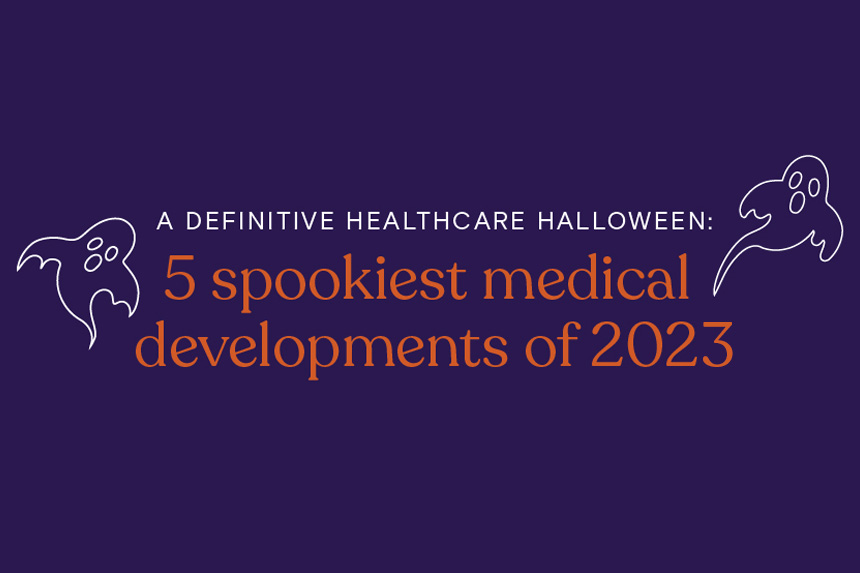A Definitive Healthcare Halloween: 5 spookiest medical developments of 2023
Oct 31st, 2023

Wriggling leeches and reckless bloodletting. Hook-beaked plague masks and eldritch talismans. Barber-surgeons wielding rusted tools—and not a drop of antiseptic or anesthetic in sight.
It wasn’t so long ago that healthcare resembled a horror movie: Healers practiced on the desperate, experimental, and often gruesome frontiers of medicine, where science and superstition swirled in the shadows.
These early practitioners were working toward the same commendable goals as modern healthcare professionals—curing disease, mending wounds, delivering comfort—but without the illumination of modern science and information sharing. Through the dark of the distant past, their efforts might look to us like butchery or barbarism; of course, these folks were just working with what they had.
In this more “enlightened” age, the medical landscape may be better lit, but it’s still home to some strange, surprising, and downright spooky stories.
Gather round, ravenous readers, and feast your eyes on the most macabre medical industry developments of the past year.
1. Ghosts in the machine: Data breaches devastate healthcare
Tales of otherworldly possessions and diabolical doppelgangers play on the fear of our very identities being turned against us or used to commit heinous acts. In the healthcare industry, data breaches strike a similarly terrifying chord.
There were at least 308 healthcare data breaches affecting millions of individuals in the first half of 2023, according to cybersecurity firm Critical Insight. This is down from the 337 reported during the same time frame in 2022 per Fortified Health Security’s mid-year report.
The good news: This rate positions 2023 as the year with the fewest healthcare-targeted breaches since 2019. The bad: The data breaches are impacting more people than ever. A record 40 million people had their data exposed this year, Critical Insight reports, with an average of 131,000 people affected per breach. (2020 still holds the record for total breaches with 663 performed in one year).
The Department of Health and Human Services (HHS) mandates all HIPAA-covered entities and business associates to report on data breaches involving protected health information (PHI) under the HIPAA Breach Notification Rule.
Most data breaches stem from third-party vendors, so healthcare organizations should develop third-party risk management strategies to ensure patient data doesn’t fall into nefarious hands.
2. COVID-19 lingers like the undead
After a couple of years of masking, shutdowns, and social distancing, 2022 was supposed to be the end of COVID and the pandemic lifestyle we’d all grown used to. Were it not for the anticipated fall flare-up, one might think COVID was “over” in 2023.
In classic horror-movie fashion, the coronavirus continues to linger long after its demise has been declared by public figures and government officials. A highly mutated version of the Omicron variant called BA.2.86 has been detected in six countries, including Denmark, Israel, South Africa, Switzerland, the U.S., and the U.K.
While COVID’s ongoing presence in our lives is a little nerve-wracking, a dozen scientists from around the world told Reuters not to be too scared: A combination of vaccination and natural immunity from prior infections make it unlikely that BA.2.86 will be responsible for much severe illness and death.
3. Paging Dr. Moreau—a hog’s heart beats in a human chest once again
Human-animal hybrids are the stuff of weird fiction, right? Not anymore—but we have highly trained doctors rather than mad scientists to thank for this advancement.
The University of Maryland Medical Center (UMMC) performed the first-ever heart transplant from a pig to a human in January 2022. Doctors took the organ from a pig that had been genetically modified to remove a type of sugar in its cells responsible for organ rejection. Remarkably, he lived for 60 days following the surgery before passing away due to "a complex array of factors". You can hear Dr. Muhammad Mohiuddin, director of UMMC’s Cardiac Xenotransplantation Program, explain the landmark procedure—and the complications that ultimately led to the transplanted heart’s failure—on the Definitively Speaking podcast.
In September 2023, doctors from the Cardiac Xenotransplantation Program performed the procedure for the second time, and by their accounts, the patient’s new porcine heart is functioning exceptionally well. On October 20, Dr. Mohiuddin shared that all supportive drugs have been withdrawn and “[the patient’s] heart is doing everything on its own.”
Human organs are in short supply, and this monumental experiment offers hope for the 104,000 people on the national transplant waiting list. Harvesting organs from animals might seem ghoulish in principle, but once perfected, the practice could prevent thousands of deaths every year.
But first, scientists will have to get the go-ahead from the Food and Drug Administration (FDA) to begin clinical trials and navigate their devilishly difficult approval process.
4. "Living robots" grown from frog embryo cells are evolving
“Xenobot” has an ominous ring to it. It’s a bit too close to the highly dangerous, rapidly reproducing xenomorphs of the Alien franchise for my taste.
Less than a millimeter long and made from living components, xenobots actually get their name from the African clawed frog, Xenopus laevis. And they don’t just share a name—xenobots are constructed from the embryonic frog’s cardiac tissue and muscle and powered by yolk from its eggs.
In 2021, researchers observed xenobots reproducing without any external programming (yikes). Now, those researchers are using artificial intelligence to make these tiny biomachines even more efficient.
Should we be bracing for swarms of self-replicating xenobots? Probably not, as they can be programmed to self-destruct after a certain period. Plus, researchers say the tiny xenobots could be used to explore new spaces, identify invisible contaminants in water, and help us understand how cells naturally adapt to changes—which in turn could lead to groundbreaking advancements in regenerative medicine.
5. Artificial intelligence continues its takeover
Ok, “takeover” is a bit much. Artificial intelligence (AI) and machine learning (ML) aren’t bringing HAL 9000 or Skynet into your doctor’s office—yet.
For now, AI/ML tech is mostly working behind the scenes in healthcare, but it’s a little spooky to consider all the ways that this technology has been silently embedded into medical systems over the last few years. In fact, AI is becoming so prevalent in healthcare that the World Health Organization released new guidance on its regulation earlier this month.
AI/ML is helping providers make more informed treatment decisions, discover new drugs, sort through massive amounts of data, and identify ideal patient cohorts for clinical trials. Google has even worked with educational institutions to develop an AI system that can predict the outcome of hospital visits.
On a broader scale, this technology is giving healthcare commercial and medical affairs teams the tools to target clinical experts and prospective buyers, segment markets, spot hidden business opportunities, and make more confident, data-driven decisions. It’s a little bit like having “the shine,” but without the haunted hotels and descents into madness.
Want a near-supernatural view of the healthcare industry and the providers, facilities, and vendors who haunt it? The Definitive Healthcare platform uses AI/ML technology to deliver the healthcare commercial intelligence you need to get ahead. Start a free trial today and see how our so-good-its-scary data, analytics, and expertise can help your organization stay out of the grave.



